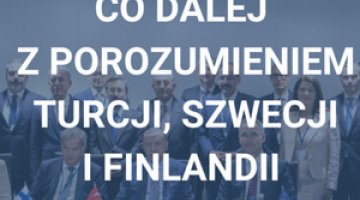Gotland and Åland on the Baltic chessboard – Swedish and Finnish concerns
Sweden and Finland are increasingly concerned about the defence of their Baltic Sea islands, Gotland and the Åland Islands, which Russia could attack in the event of a regional crisis or conflict. In mid-September Sweden decided (earlier than planned) to permanently station a mechanised company of Swedish Land Forces on the island of Gotland. In addition, in mid-October the Swedish military publicly objected to the use of the Gotland port of Slite for the construction of the Nord Stream 2 gas pipeline, due to concerns about the defence of the island. In Finland, in turn, debate on the defence of the Åland Islands was reignited after the Finnish defence minister suggested in mid-October that Finland should re-examine archipelago’s demilitarized status. As long as Sweden can be expected to continue reinforcing Gotland’s defence, so it is most likely that Finland will try to make the Åland Islands’ defence to be an important element of strengthening its bilateral military cooperation with Sweden, without any formal change in the status of the Islands.
Gotland: a strategic island for the security of the Baltic Sea region
Gotland is of strategic importance in the Baltic Sea basin. Sweden is concerned that in the event of a crisis or conflict between Russia and NATO, the island would be occupied by Russian forces. Swedish analysts have drawn up two scenarios. In the first, in a situation of strained relations between Russia and NATO, Moscow would occupy Gotland and would deploy long-range air and coastal defence systems on it, thus gaining regional superiority over NATO forces in the air and at sea and demonstrating to NATO that the Baltic states are indefensible. In this scenario, Russia would not launch a direct armed attack on the Baltic states, it would however increase the political and military pressure on NATO. Moscow would count on undermining the credibility of the Alliance and on gaining concessions from NATO without the use of military force against NATO members. The occupation of Gotland would not activate Article 5 as Sweden is non-aligned. In the second scenario, Russia would decide to start a regional conflict with NATO with the US being politically and militarily involved in a regional crisis in Asia-Pacific. In this scenario before making a direct attack on the Baltic states, Russia would occupy Gotland and make air strikes against the military infrastructure in Sweden, to prevent its possible use by NATO forces.
In Sweden there has been an ongoing discussion for several years on the need to strengthen the defence of Gotland. On the island, which was once heavily militarised, the Swedish Armed Forces have maintained an insignificant presence during the last decade (one home guard battalion, and 14 Leopard 2A5 tanks in storage without crew). This was brought about by a redefinition of the threats and challenges, and the tasks of the Swedish Armed Forces. Since the end of the 1990s, the Swedish military has been focused on crisis-management operations around the world - successive governments perceived that there was no conventional military threat to the security of Sweden.
In 2015 the Swedish parliament adopted a new strategy for the country’s defence policy and the development of the armed forces in the period 2016-2020, which will introduce substantial changes to the Swedish military presence on Gotland. According to this strategy a battle group consisting of two companies (one mechanised and one armoured) will be permanently stationed on Gotland in 2018, augmented by an infantry company which, if necessary, could be quickly deployed to the island from the Swedish mainland. The number of exercises by all branches of the armed forces including air defence units on and around the island will also be increased. In September this year however, the Supreme Commander of the Swedish Armed Forces, gen. Micael Bydén, with the approval of the Defence Ministry, decided to deploy the mechanised company (numbering about 150 soldiers) on the island in advance, on the grounds of the deteriorating security situation in the Baltic Sea region. In October, in turn, he spoke out against the use of the Swedish port of Slite on Gotland in the construction of Nord Stream 2 by the Russian Gazprom, stating that Russia could prepare military activities on the island under the guise of works related to laying the gas pipeline. The Supreme Commander’s negative opinion, however, need not prevent any decisions by the island’s local administration, since the storage of pipes for the construction of Nord Stream 2 will bring economic benefits to the community.
The Åland Islands: Finland’s Achilles heel?
Discussions in Finland on its ability to defend the Åland Islands and the legal status of the archipelago were revived after the annexation of Crimea by Russia. The debate gained momentum in October, after the Swedish decision to reintroduce a permanent military presence on the island of Gotland. The Åland Islands are an autonomous Swedish-speaking territory of Finland. The local population puts an emphasis on their separate identity, which differentiates them from the Swedish-speaking community in mainland Finland, who identify themselves mainly as Finns. The archipelago is demilitarised in peacetime (the presence of military facilities and armed forces is prohibited) and neutralised in time of war (conduct of military operations on or from the territory of the Islands is prohibited), on the basis of a number of bilateral and multilateral international agreements. The most important is the convention of 1921, the parties to which are Finland, Sweden, the United Kingdom, Germany, France, Denmark, Poland, Italy, Estonia and Latvia. In accordance with its provisions, in the case of aggression towards the archipelago, Finland is committed to its defence. Under the Soviet/Finnish agreement imposed in 1940, Russia keeps a consulate on the Åland Islands, the task of which is to monitor the demilitarisation of the archipelago.
In peacetime Finland has the right, among other things, to send armed forces to the demilitarised zone to restore public order, and in the event of a conflict in the region it can mine the Åland Islands’ territorial waters. Despite this, there are fears that the archipelago’s demilitarised status may be an incentive for Russia to occupy the Islands (in the event of a regional crisis or conflict) or to conduct sabotage on them, for example, in order to prevent Finland’s membership in NATO.
In Finland, the remilitarisation of the Åland Islands is favoured by the armed forces and a substantial part of the expert community. Defence Minister Jussi Niinistö has on several occasions proposed a discussion on the status of the Islands. The defence ministry has not submitted any specific proposals, but several possibilities are being debated among leading experts, including the remilitarisation of the Islands (unilaterally or on the basis of multilateral arrangements); maintaining the status quo and getting Sweden to take joint responsibility for the defence of the archipelago; as well as obtaining guarantees for the security of the Islands from NATO (all the parties to the 1921 convention, apart from Sweden and Finland, are now in NATO).
The defence minister’s proposal has met with a cool reception from the centre-right government (composed of the Centre Party, the Finns Party, and the National Coalition Party), and with open criticism from the leftist opposition. The Prime Minister and the President have also spoken against changing the status of the Åland Islands. Supporters of the status quo argue that the remilitarisation of the Islands would increase tension in the region, and that the current status does allow them to be defended effectively. The Islands’ remilitarisation is strongly opposed by the residents and the local authorities, who fear that the appearance of Finnish-speaking troops on the archipelago would be the first step towards limiting the autonomy of the Åland Islands and would pose a threat to their Swedish character.
Helsinki is currently unlikely to take action towards a remilitarisation of the Åland Islands due to insufficient political support. It would also be difficult to get guarantees from NATO for the Islands, in connection with the maintenance of Sweden and Finland’s policy of non-alignment. However, Finland may propose the question of the Åland Islands’ defence to be an important element in strengthening its bilateral military cooperation with Sweden.
MAP
Gotland and the Åland Islands






